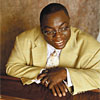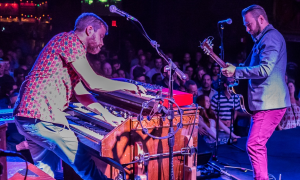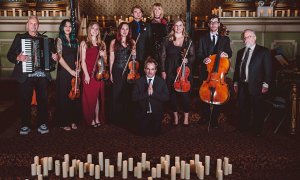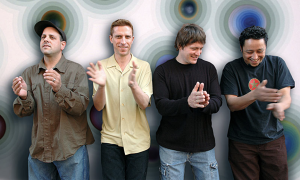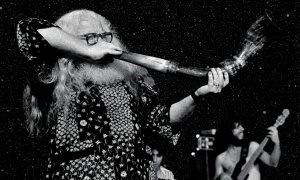Home » Jazz Articles » From the Inside Out » One Look Back
One Look Back
 Johnny Blas
Johnny Blas
Indestructible Spirit
CuBop
2007
"This album differs in style, it has more of a funky jazz beat with a twist of Latin," suggests Johnny Blas. "Kind of a throwback to the '70s sound." Indestructible Spirit also represents rebirth for Latin percussionist Blas, who leads a brand new band and even performs on saxophone.
"Oaklands Mambo" opens the set up bright and tight, a nicely loping Latin instrumental groove with trombones and other horns blowing like a blast furnace while percussion drives the rhythm section in the engine room. "Puerto Rico Rico" downshifts the tempo of its Latin groove but maintains its velocity, with its cuatro (small ten-stringed guitar) solo snaking throughout like the song's nervous system. The dancing continues with "Boogaloo Blas," which is precisely that: A funky, head-bobbin' Latin boogaloo that moves in precise syncopation but under the canopy of a horn chart that seems to spread the warm and carefree sunshine of the Caribbean isles.
"Afro Rican" reaches further out: Blas opens with a percussion solo that resounds with crossing Puerto Rican and African rhythms, while the lead saxophone slices through the mix with a cutting sound that suggests Yusef Lateef's explorations of eastern instrumental music (and also quotes from 'Trane's version of "My Favorite Things" to fine effect). Blas' title track goes even further as it sets up a humming, beeping flow of synthesized vocals, keyboards and percussion, and then saxophone and trombone seem to rhythmically cut in against the flow, this set's most ambitious rhythm arrangement.
Closer to earth, "Barry Rogers" revisits the ballad that first appeared on Blas' live debut (A Night in LA, 1995), expanded to accommodate abundantly vibrant melodic and improvised playing from the horn and rhythm players; its lead saxophone intimates the melody of the dreamy classic "So Many Stars" and the soulful yet still jazz sound of Grover Washington, Jr. (especially Grover's Kudu and CTI recordings).
You can read in its notes how personal this recording became for him: "What you hear will be completely different than any of my other recordings. It is a representation of who I have become once again." If this is the sound of that, then Blas has become one seriously multifaceted and funky dude.
 Club d'Elf
Club d'Elf
Perhapsody Live 10.12.06
Kufala
2007
A floating ensemble in every best sense of "floating," Club d'Elf is tethered to bassist Mike Rivard and the more or less house rhythm section from Rivard's extended residency at the Lizard Lounge, a progressive if not experimental music club in Boston. After releasing numerous live albums—the best laboratory for their mainly improvised, genre-munching music—they released their first studio album (Now I Understand) in late 2006. What did they do at their studio album release party? Why, perform and record it for another live album—Perhapsody, a double-CD set that overflows with jam.
Most tunes led by Tom Hall's tenor saxophone suggest jazz fusion hijacked into more adventurous (and sometimes dangerous) territory. Hall's sax shapes the structure and leads the instrumentation of "Life of the Mind," for example, even though the music those instruments are actually playing sounds more attuned to experimental hip-hop and funk. He later leads the almost jolly yet crumpled bop melody of Steve Bernstein's "Cave Man," kicked by Erik Kerr's whipcrack snare drum down the echoing corridor of Rivard's bass heartbeat, which shifts into a thick jungle vamp for a middle section that seems designed to let the music breathe, culminating in a Rivard / Kerr dialogue / diatribe that bombdrops atomic funk.
Like quicksilver, the rest of this moves even more all over the place than that. Several longer tunes (such as "Sin Gas" and the title track) explore collective electric rock-jazz improvisations. "Berber Song" may be based on a form of traditional Moroccan folk music but its frantic lead guitar, clattering backdrop and rhythmic churn exemplify the busy-ness of modern American life. Similarly, "Jar of Hair" rocks hard through music that doesn't even come close to rock 'n' roll, as Rivard's bass seems to play "Tag—you're it!" with Kerr's drum patterns under the cover of an electric guitar psychedelic freakout.
I've been listening to Perhapsody for several consecutive weeks and still haven't figured out how to explain or describe this music. Which is is probably the most honest and accurate Club d'Elf review of all.
 The Harlem Experiment
The Harlem Experiment
The Harlem Experiment
Ropeadope
2007
Volume three in Ropeadope's Experiment series follows similar musical experiments that represent Philadelphia and Detroit. "We look to Harlem as ground zero for all that is modern day 'American' music," explains co-producer (and Ropeadope founder) Andy Hurwitz. "Whether you call it jazz, R&B, hip-hop or rock, all of it passed through the neighborhood's gates."
"In addition to Harlem's rich African-American history in jazz, R&B and funk," continues co-producer Aaron Levinson, "It has deep Latin music roots with mambo and salsa, and this sits alongside a historic period in Jewish music, especially klezmer. It's an ambitious undertaking but I think what makes Harlem Experiment so significant is that all of these cultural narratives are presented under one roof."
This walk through the neighborhoods of Harlem journeys much deeper than its surface streets, sending postcards from historic milestones along the way. Arranged into rhythm and instrumentation full of congas and clarinets (sort of Latin MEETS Klezmer), Taj Mahal's rubbery vocal turn through Cab Calloway's "Reefer Man" is a flat-out scream. Steven Bernstein's trumpet leisurely surveys the landscape of Eddie Palmieri's scenic "Harlem River Drive" while the rhythm section smoothly glides like public rail underneath. "Drive" segues right into Don Byron's typically amazing, dexterous turn on clarinet in an instrumental version of "Bei Mir Bist Du Schoen," a hit pop song for the Andrews Sisters with very Yiddish-sounding guitar chords.
Based on the Machito Orchestra's arrangement of Benny Goodman's "Stompin' at the Savoy," "Mambo A La Savoy" spotlights Latin jazz guitar by Carlos Alomar, who served as guitarist in the Apollo Theater house band when he was just 16 (and moved on to subsequent gigs with, among others, David Bowie). "A Rose in Spanish Harlem" is obviously perfect for this theme and comes served in two acoustic guitar flavors, one with an earnest vocal from James Hunter and the other blossoming like a hothouse flower into an instrumental theme.
"Think" might not be as obvious but it's no less thematically perfect: Led by Queen Esther's self-assured vocal, it combines James Brown's message of self-empowerment through intellectual self-improvement with the chorus from "It Takes Two" by Harlem native Rob Base with DJ E-Z Rock; Base's original sampled the original version of "Think" by Lyn Collins, one of Brown's more renown backup singers, bringing the tune full circle to Harlem, back home.
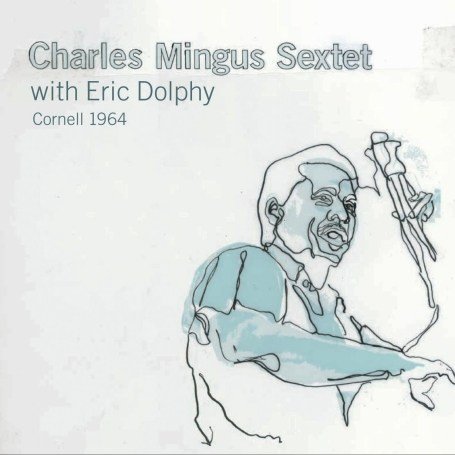 Charles Mingus Sextet with Eric Dolphy
Charles Mingus Sextet with Eric Dolphy
Charles Mingus Sextet with Eric Dolphy
Blue Note
2007
Confrontational, sprawling and historic, this resurrected March '64 performance by one of his favorite bands—Johnny Coles (trumpet) and Clifford Jordan (saxophone) with favorite sons Dannie Richmond (drums), Jaki Byard (piano) and Eric Dolphy (reeds, flutes)—presents the muse of Charles Mingus in all its terrible glory.
Split here between two CDs, this performance begins with two more or less solo pieces. Byard renders an amazing unaccompanied performance in "ATFW," his combination tribute to Art Tatum and Fats Waller—blistering runs into complete stops, an elegant waltz time passage and then boogie-woogie. Mingus next commands "Sophisticated Lady" in mostly solo bass except with the occasionally whispered piano chord.
Each CD hangs from its thirty-minute centerpiece, each a storied Mingus original. "Fables of Faubus" purposefully swings its wobbly, roly-poly melody on the first CD, with Richmond dropping bass drum bombs that literally make Mingus shout for more; Mingus of course solos with dexterity and vision that make you wonder how ANYone's fingers could keep up with such a torrent of ideas. Disc one ends with their spirited collective rampage through "Take the 'A' Train": The Mingus-Richmond rhythm engine builds up locomotive power—Mingus pummels this rhythm, almost daring Richmond to keep pace—as Byard's boogie piano solo rocks the caboose harder than Ellington's more refined piano style.
"Meditations" open disc two in the serious, contemplative spirit communally created between Mingus' bowed playing, Byard's studious piano and Dolphy's flute. While Coles' trumpet and Jordan's saxophone rip through its subsequent tumult, Byard sounds bent on knocking down structures that the other ensemble players build up. Written to honor Dolphy, who had confided plans to leave Mingus' employ after this sextet's scheduled European tour, Mingus' jumpy-blues "So Long Eric" sounds more joyous than your usual "farewell." (Dolphy remained in Europe after this tour, suddenly lapsed into a diabetic coma and died in June '64 at age 36.) Dolphy's dancing flute is also the perfect instrument to lead the evening's finale, Fats Waller's fun and lively "Jitterbug Waltz."
As it moves so assuredly through this program of Mingus originals cast in Strayhorn, Ellington and Waller, you almost wonder if Live at Cornell is the sound of Mingus writing his own history of American jazz—or perhaps even more, the sound of him writing his own place within it.
 James Blood Ulmer
James Blood Ulmer
Bad Blood in the City: The Piety Street Sessions
HYENA
2007
"Blood wrote these songs that are the essence of the blues," suggests producer and guitarist Vernon Reid. "They're politically incorrect, they're sad and haunting, they're pissed off and on an existential level, they address the complicated concept that is America, which is something Blood's been dealing with since the beginning of his career."
You might forgive a certain about of hyperbole from the producer, but even one listen to Bad Blood in the City proves that what Reid posits is absolutely true: This inscrutable bluesman's new set carves out rough-hewn electric screams that transcend blues music to become blues mythology. Bad Blood sounds eternal.
This set list is full of legend, featuring blues written by Howlin' Wolf, Bessie Smith, John Lee Hooker and others interwoven with new Ulmer compositions about the physical and sociological wallop of Hurricane Katrina and its aftermath.
Ulmer's "Survivors of the Hurricane" rips this set open, its backbeat churning thick and hot behind the harmonica's blue howl and Ulmer's graveled guitar and vocal. This hurricane sound blows through "Sad Days, Lonely Nights" (Junior Kimbrough), brutally stomping its single riff into bloody ground. Ulmer's "Katrina," his thematic focal point, completes this opening trilogy with rippling production that makes his guitar and vocal sound ironically, angrily underwater.
A skeletal arrangement of "This Land is No One's Land" (John Lee Hooker) showcases one of Ulmer's best vocals alongside its scrawled guitar hook; Ulmer genuinely reaches the cold, black depths in which Hooker's music singularly swam with a voice that chills your bones with its pain and anger. At first it seems impossible, but this take on "Commit a Crime" (Howlin' Wolf) sounds even more powerful: The rhythm section and harmonica seem to shred the accompaniment while Ulmer's lead guitar slices off huge chunks from their volcanic sheets of blue sound, a blues so powerful that the musicians sound barely able to harness and direct it.
And yet...at the end of Bad Blood, after its onslaught of darkness and rage, Ulmer's "Old Slave Master" leaves you dancing with a four-on-the-floor three-minute rave-up that's the blues equivalent of "Twistin' the Night Away."
Tags
PREVIOUS / NEXT
Support All About Jazz
 All About Jazz has been a pillar of jazz since 1995, championing it as an art form and, more importantly, supporting the musicians who make it. Our enduring commitment has made "AAJ" one of the most culturally important websites of its kind, read by hundreds of thousands of fans, musicians and industry figures every month.
All About Jazz has been a pillar of jazz since 1995, championing it as an art form and, more importantly, supporting the musicians who make it. Our enduring commitment has made "AAJ" one of the most culturally important websites of its kind, read by hundreds of thousands of fans, musicians and industry figures every month.


